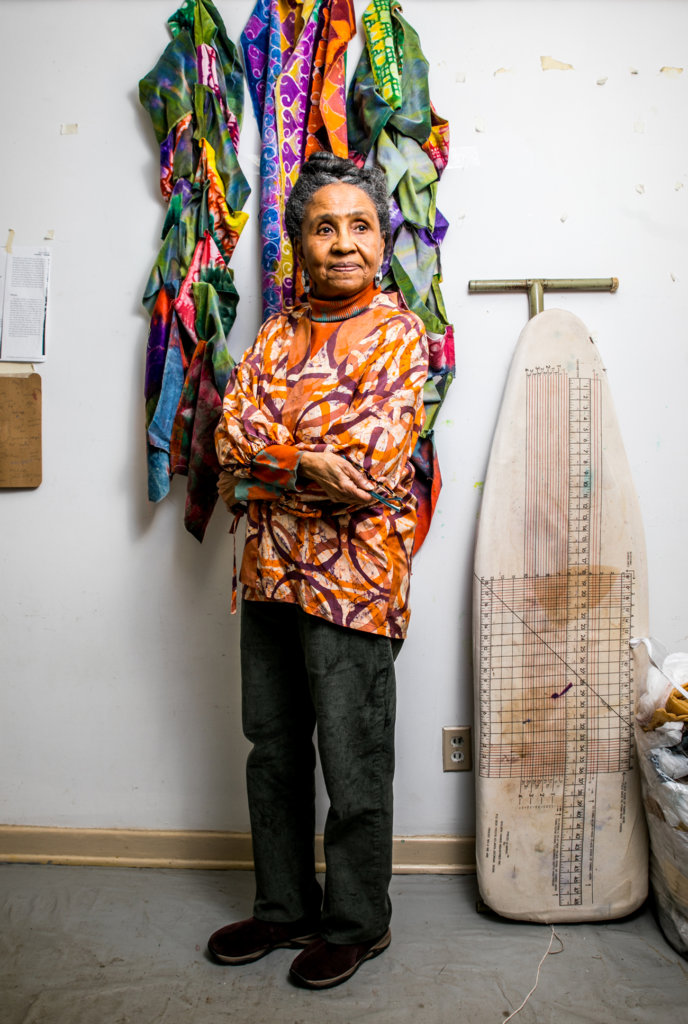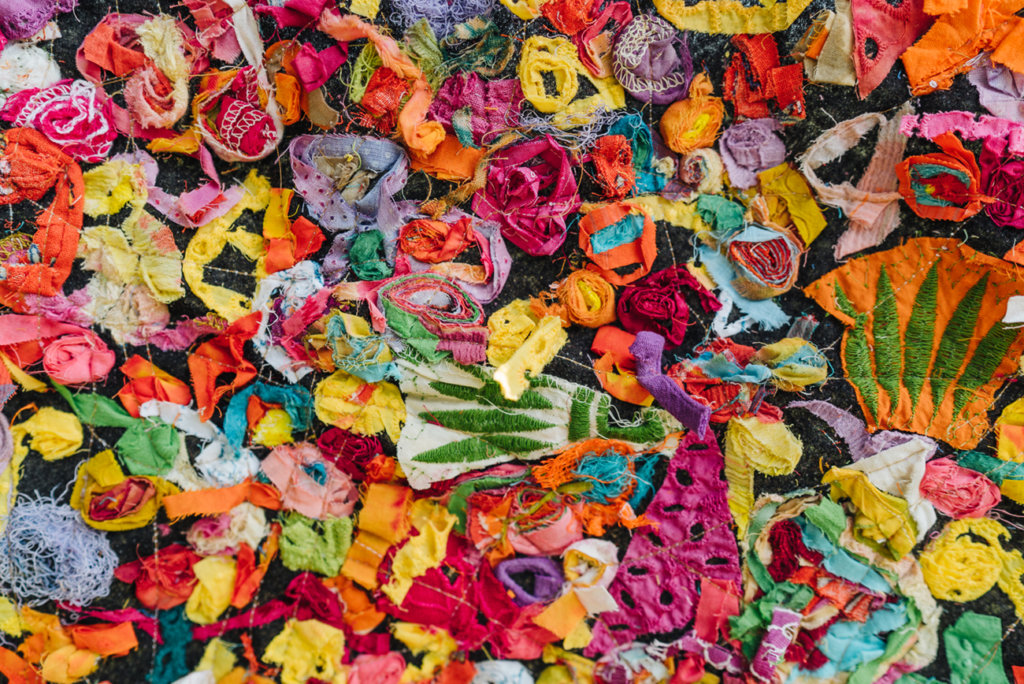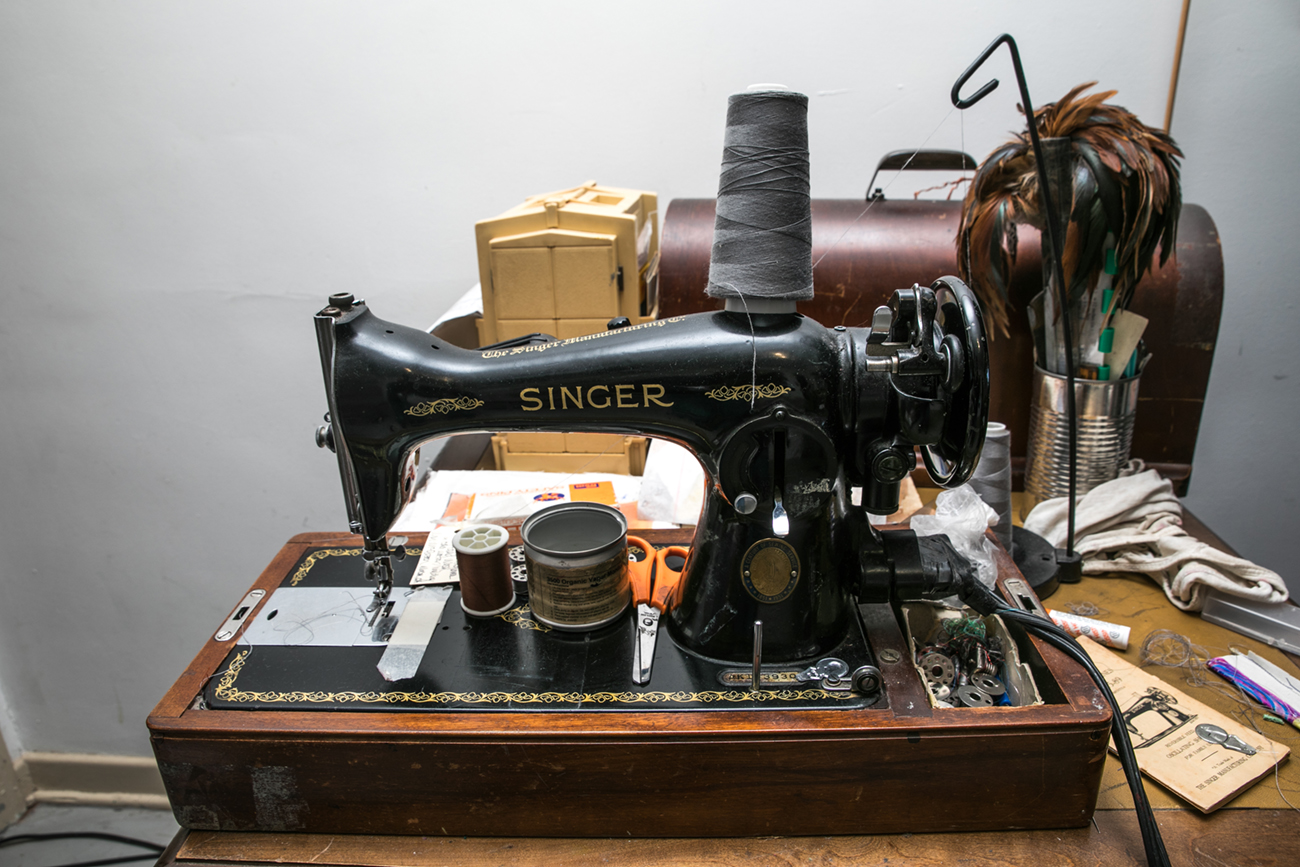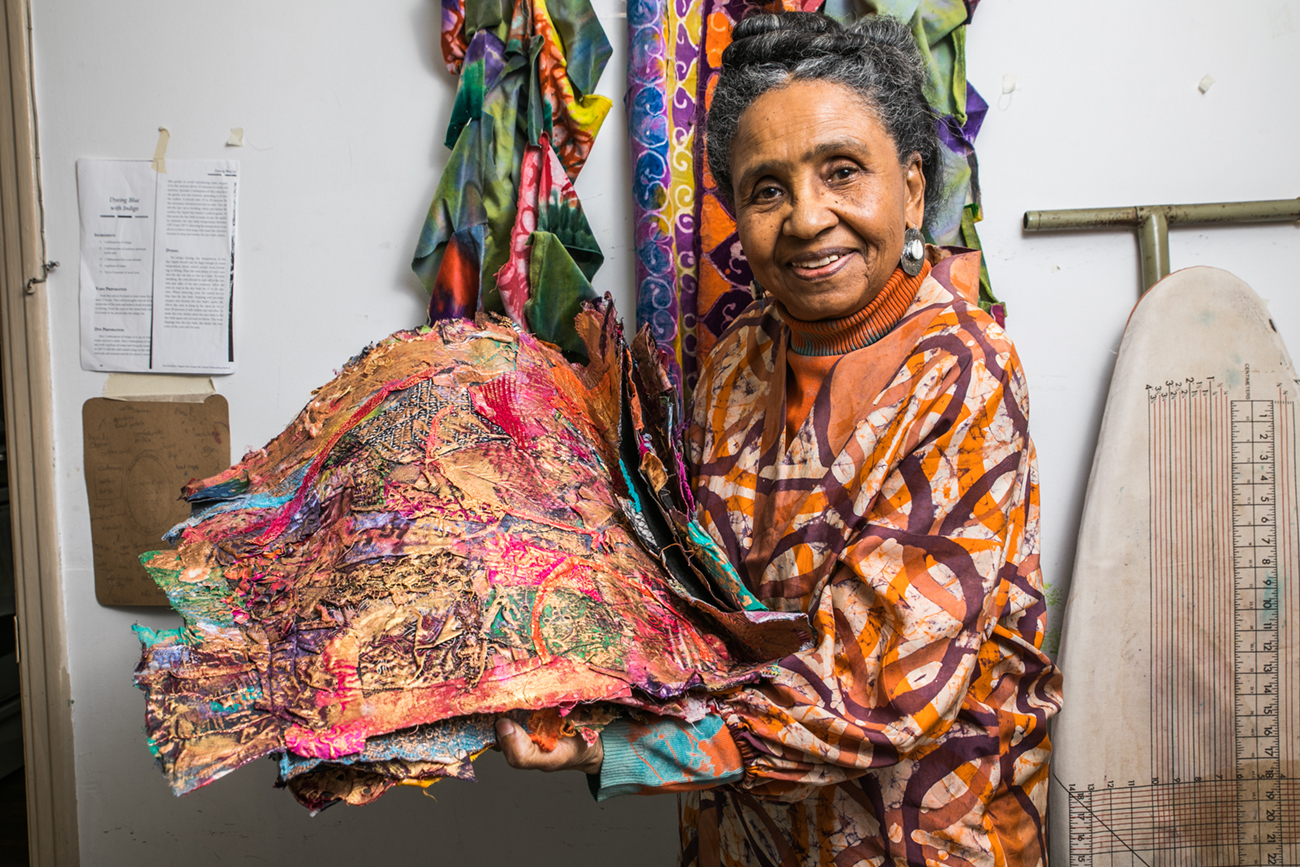At 77, textile artist Wini McQueen prepares for her biggest exhibition yet
By Traci Burns
Photography by Matt Odom
“What drives me at this moment is my desire to look back at my life experiences and share them with my community,” sa
id
Wini McQueen. “There are places that might have been friendlier, or far more art-oriented, but there was something about coming to Macon that made me feel like I had a home. I had a
place here. People needed me, they encouraged me, they supported me. I couldn’t walk away from it.”
McQueen, a contemporary textile artist, is a beloved fixture of Macon’s art scene. She’s a gifted storyteller, a self-taught craftswoman, a lifelong learner and a creative innovator well-known for the way she redefines the traditional art of quiltmaking via modern textiles and techniques.
Her work has gained national recognition and traveled to museums as far away as Japan. She won multiple grants and fellowships that enabled her to travel and teach in Africa. She curated two large-scale exhibits –
one in Macon, one in Africa – documenting crafts in African-American communities. Her list of exhibitions, publications, educatio
nal experiences and awards is remarkable by any standards, except maybe her own.
“It’s too long,” McQueen laughed. “I tried to make myself a one-page resume, but it was hard. All that stuff, it just kept going and going and going, and I thought, enough! Who wants to know about another exhibit or another classroom? I watched the sun set behind Mount Korogo in rural northern Cote d’Ivoire while the women prepared their bobbins for spinning work the next day – that’s my real resume. That’s the meat of it.”
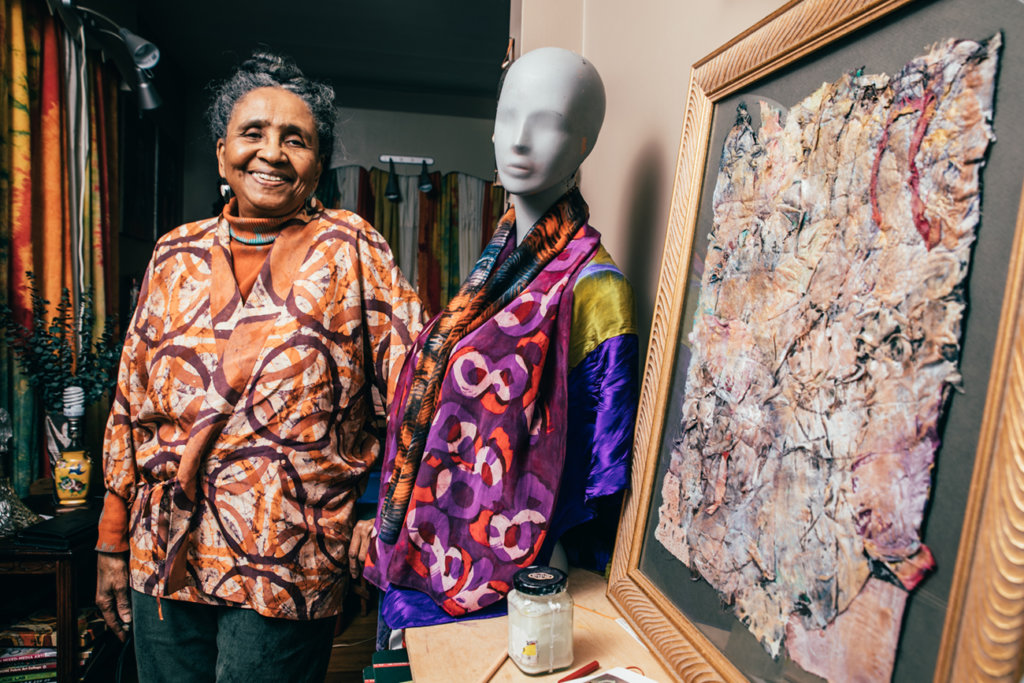
Now, at age 77, McQueen is fully immersed in creating and preparing material for a major three-gallery exhibition that will open June 19 at the Museum of Arts & Sciences. Titled “The Covering,” this exhibit sees McQueen burrowing deep into the literal source material of her life’s work – cotton.
From a young age, she devoted herself to mindfully exploring the textiles of the African diaspora. “Never in my life have I seen a subject as compelling as cotton,” she said.
McQueen has been growing cotton in her front yard, dutifully observing it firsthand, though she admitted she’s not the green thumb type. For her, it’s research.
“There’s a story there,” she said, “and I want to mine it for metaphor.”
A cotton boll, its dense, clumpy fibers painted in vibrant shades, sat on a nearby table at her studio. She picked it up with graceful fingers, held it out until light illuminated the bright, fuzzy filaments.
“I’m calling this a corsage,” she said. “I’m driven by the idea of pulling apart the things that come out of a cotton seed, turning them inside out and upside down.”
McQueen’s exhibition will feature examples of her work from previous artistic periods alongside new paintings, handmade and hand-dyed clothing and a room-sized large-scale conceptual installation. This endeavor is larger in scope, scale and theme than anything she’s done before. She’s eager to open it up to the Middle Georgia community that nurtured her.
“I want my work to speak of the beauty and horror of learning who I am, where I came from and what I’ve seen,” she said.
Susan Welsh, executive director of the Museum of Arts & Sciences, said, “Many of her older quilts fall close to folk art, but Wini’s newest body of work feels distinctly different – a densely layered, conceptual narration of her experience as an African–American woman in the South.”
An artist’s roots
McQueen was born in New Jersey during World War II and moved to Durham, North Carolina, the city she considers her hometown, as a small child. She didn’t grow up around cotton – Durham is tobacco country – but there was a cotton mill nearby where her grandfather worked as a boiler stoker, and he’d bring little swatches of cloth home from work. Soon enough, McQueen made her first quilt.
“Never mind how you’re supposed to make a quilt,” she laughed. “I just saw these rows of blocks going across, and I joined them.”
Not long after that, a third grade McQueen liberated the oil paints from a paint-by-number set and created a scene of Mexican dancers on all four corners and in the center of a tablecloth. Her family saved her early artwork; some pieces can be found in her family tree quilt, on permanent display at the Museum of Arts & Sciences. She’s saving more to use in future projects, quite literally creating art with the fabric of her life.
Near the end of her time at Howard University, McQueen was introduced to textile design by a professor who noted her innate talent. She’d majored in English, but felt compelled by this new interest. With the support and encouragement of her boyfriend at the time, Marvin Holloway, she developed a vision of what she wanted her life’s work to look like.
“I had this five–year plan that I haven’t completed yet, even though 50 years have passed,” McQueen laughed. “I thought I might develop a textile design business. But first I’d have to teach myself textile design.”
During the late 1960s and early 1970s, McQueen began working with linoleum cutting for hand-stamping, painting and printing fabrics. She took various jobs, learning while working and absorbing the art around her. She started compiling data on present-day craft practices in the African-American community, meeting and talking to practitioners throughout the South.
While visiting one artist’s western North Carolina, shotgun house, something caught her eye.
“I looked over and saw this pile of chaos. It was amazing. I’m in these people’s bedroom, and I had to stop and ask to take a picture – it was a quilt made of neckties,” McQueen said. In that moment, inspiration hit, and she saw the malleable potential in quilting.
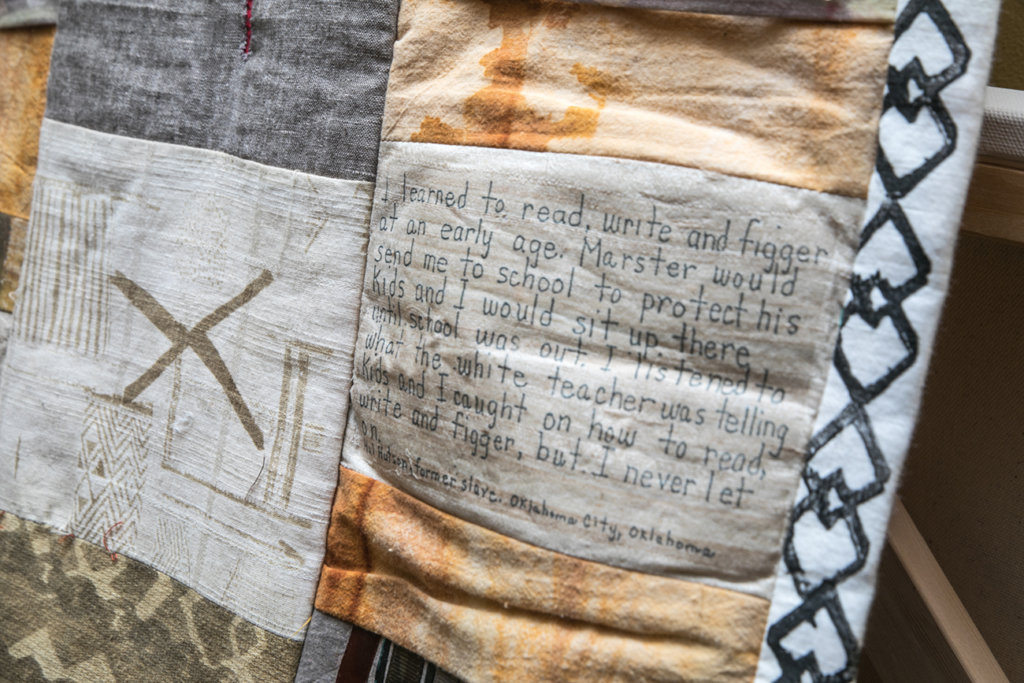
Flourishing and traveling to paradise
A change of scenery happened for McQueen in 1976, when love brought her to Macon. “His name was Milton Dimmons, and he died exactly 10 years ago,” she said.
Dimmons and McQueen were work partners, though his background was in law. He helped her with the mechanical aspects of her art, made equipment, dealt with whatever money there was, kept them out of trouble with bills and taxes.
“He was my best critic,” she said warmly. “And it worked! Even though he wasn’t an artist, he had a very keen vision of what was beautiful.”
During the next few decades, McQueen flourished as an artist, finding her niche in Macon and filling it beautifully. She had her own one-woman show at the Museum of Arts & Sciences, and she was able to leverage her accolades to earn grants to travel to Africa to study and teach. Her first grant came from the Lila Wallace Reader’s Digest International Foundation.
“I grew up reading my mother’s collection of Reader’s Digest Condensed Books, and I always wondered, why does she get these? Now I know she was supporting my grant,” laughed McQueen. “I was steppin’ in high cotton when I went to Africa with Lila Wallace’s money!”
Paradise – that’s the word McQueen uses when discussing Africa. She experimented with different techniques for fabric printing there and taught at an arts school, but images of everyday African life resonate most with her now – the women she met walking down the road, or saw lined up waiting for a taxi to take them into town.
“Nobody had any riches, but they all had tie dye and woven fabrics of all colors, and it was such a beautiful swirl,” she said. “They have a different appreciation of beauty than I think we have in this society. They have so few material resources that they appreciate what they have, and they work to create beauty not just for themselves but for their community. It’s actually considered good etiquette to be well-dressed, well-groomed. They haven’t dressed for the camera like we might. It’s a whole different motivation.”
Sustained by memory
After a series of people close to her died, among them her husband and her gallery representatives, McQueen said, “I was out there. I was alone. I had to rethink everything.”
With her partner in work and love gone, McQueen felt adrift, but anchored herself with the familiarity of creation.
“I didn’t have help moving and stacking and making machines and devices,” she said, “but I started working small – making notecards, hand-dyeing socks.”
Her family kept her afloat during rough moments.
“I had seven sets of aunts and uncles, grandparents, mothers, all these people who supported me and encouraged me to be a learner. I don’t think they meant for me to be an artist,” she laughed. “Even at that time, art was a very vague thing. But they gave me whatever knowledge they had. They weren’t always sophisticated but they taught me the things they knew. And they always told me that the most important thing in life is what happens in your mind, in your brain, between your two ears. Their memory sustained me.”
And on a larger scale, community and the fire of activism and social justice kept her afloat. Being an active participant in the Civil Rights Movement was both an honor and a reminder that there was always more work to be done.
“When I was a little girl, I saw the lowly position that black people had in our society and I thought, I wish things were better than this. The Civil Rights Movement was my opportunity to develop a desire for what I wanted to see happen – and basically, for me, that was employment, rewarding employment. I grew up in Durham between the two campuses at Duke University, and many people in my community were servants to Duke. They cleaned, they cooked, they laundered. I knew the difference. I did not want to be that kind of victim, and that probably pushed me along, kept me going during harder times.”

Cotton, for granted
There’s a basket stuffed full of clothing labels, separated from their garments, that McQueen thinks will end up in her show, perhaps as a handbag.
“When you go to the store and buy clothing, you don’t think about much other than: Does this look good on me? And how much does it cost? But I’ve had the extreme pleasure – or horror – of ripping so many garments apart to turn into dyeing supplies for my work, and after so many hundreds of them, you begin to think about people all over the world and what goes into making what we take for granted. It begins with people who cultivate cotton. It’s a product of very hard work. And the people who have done that work have some horror stories.”
McQueen would love for cotton organizations – like the Perry-based Georgia Cotton Commission – to pay attention to what happens when artists get their hands on cotton, and perhaps even offer much-needed financial support for these projects.
“Some of the memories associated with cotton need to be replaced with something beautiful, as a tribute to the work our people did, and the way they suffered,” she said.
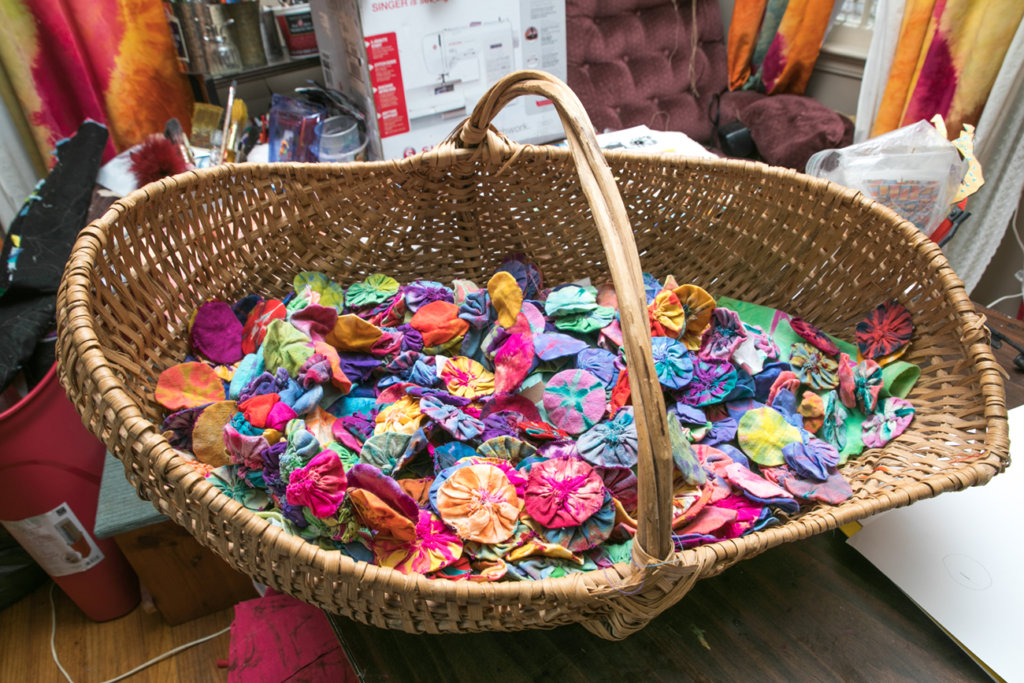
‘You’ve gotta go big’
About a year ago, McQueen was surprised to hear from Marvin Holloway, her college beau. It had been 50-odd years since they’d last been in contact, but he was coming through town and hoped to meet up, talk about old times, maybe look at her artwork. She showed him some pieces; he got excited, wanting to see more, more, more. “He said, ‘Oh, you’ve gotta go big!’” McQueen laughed, “and I said, ‘Big? How big you mean? What are you talking about? I like to make socks and scarves!’”
Holloway gestured broadly with his hands – as big as this wall, he said. So, McQueen is going big, with the encouragement and support of her old boyfriend, who is now her new boyfriend – she refers to him charmingly as Boyfriend, as if that’s his proper name.
When they were at Howard together, Holloway told her he’d stand by her until she had a vision of what she’d do for her life’s work – and he’s here, all these years later, helping and inspiring her as she prepares for her largest-scale project yet.
With a few months until “The Covering” is set to open, McQueen’s studio is strewn with her artwork – glorious piles of colorful fabric, some painted, some textured. She’s working small now, but planning big, looking forward to assembling these components into their final form.
“I don’t think I make quilts anymore,” she observed. “I think – I hope – I’ve evolved. I think I’m taking quilting elements through a new passage and into an abstract form that is enlightening and encouraging.”
It’s exhilarating to see McQueen gathering every bit of the skill, knowledge and expertise she’s garnered over her 77 years and using it to push herself boldly forward as an artist, to reinvent and explore, to provoke and to soothe.
“When you get close to the end of anything, including the end of your life, you get realistic. You say, ‘Well, this is it. You better work,’” she said. And that’s exactly what she’ll be doing for the next few months as she prepares for “The Covering.”
“One of the nicest gifts I ever received was the opportunity to have the support to decide what I wanted my life’s work to be. And I’ve always done what I wanted to do. I’ve never suffered through jobs in hopes of becoming an artist,” McQueen said. “There hasn’t been a day that I woke up and didn’t want to do what was before me. It’s been over 50 years now and I still feel grateful, and that’s why I’m making this work, doing this show – to share myself with my community.”
